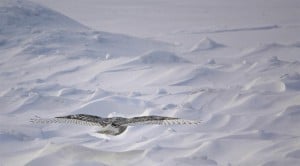Snowy Owls are staging an incredible “invasion” this year across eastern North America. The numbers of owls reported are higher than ever before. Owl sightings have been coming in from Atlantic Canada (301 seen in one weekend near Cape Race, Newfoundland), Quebec, the Northeast U.S., the Great Lakes area, and one as far south as Jacksonville, Florida. Another pioneering owl was even spotted in Bermuda. At least six owls have been seen in the Kawarthas so far this winter, namely: at Hamilton Bay on Stony Lake (see Dec. 9), Trent University (see Dec. 17), Chemong Road at 3rd Line (see Dec. 11), Millbrook (see Jan. 10), Pontypool (see Dec. 27) and Oakwood (see Jan. 12). As of January 10, the Chemong Road owl was still present.
- These invasions, which happen every 10 to 15 years, are thought to occur because of variations in cyclical prey and predator populations in the Arctic, but the exact dynamics behind the movement still are rather poorly understood.
- Snowy Owls and other predators have cyclical populations linked to prey abundance. Lemming population cycles likely drive much of the survival and breeding success of Snowy Owls. We know Snowy Owls will skip breeding seasons when prey is scarce but may produce large clutches (up to 11 eggs!) when prey is abundant.
- Most years, Snowy Owls will only successfully raise two young but this past summer, due to lemming abundance, researchers in the eastern Arctic were seeing all of the young survive.
- The biggest driving force in Snowy Owl invasions may therefore be highly productive breeding seasons (with multiple young fledged per pair). Periods of summer lemming abundance may drive these invasions more than lemming scarcity.
- The high proportion of first-winter (immature) owls during most invasions provides evidence that high breeding productivity is a major factor in these invasions. Like most birds, Snowy Owls have a 60-70% mortality rate before their first birthday.
- Snowy Owls are highly mobile. In addition to winter movements, they may move over 1000 km across the Arctic in summer. This is presumably a strategy for the birds to locate areas with abundant rodent prey for their young.
- In addition to rodents, Snowy Owls eat lots of birds, especially small waterbirds like ducks and even alcids … many owls on the Great Lakes and Atlantic coast prey heavily on waterbirds, flying out over the water to hunt them, especially at dusk.
- Darkest birds are usually young females and the whitest birds usually adult males, it’s especially hard to determine the age and sex of intermediate birds.
- It is important not to stress the owls by approaching too closely or causing them to take flight.
- SOURCES: eBirds, The Globe and Mail (Jan. 9, 2014)
